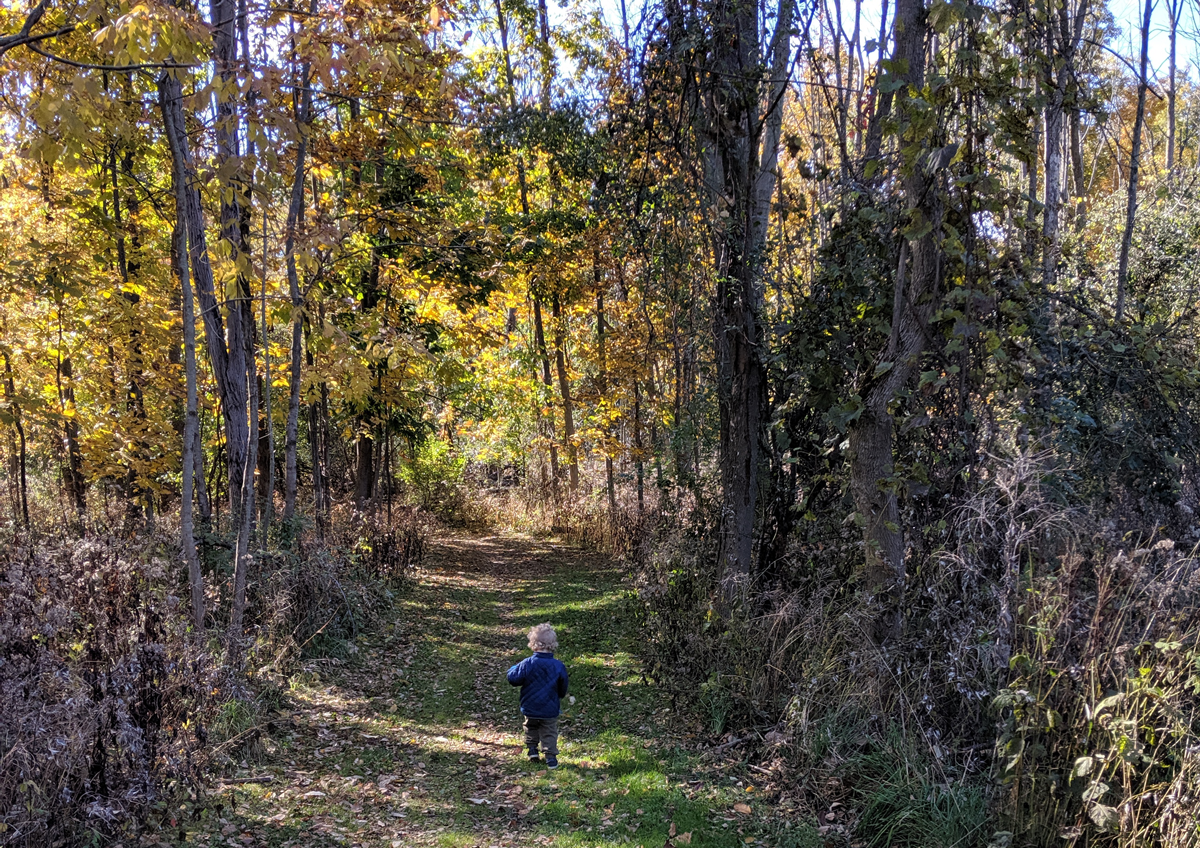1. Things in the woods
On a recent walk in Oatka Park in Scottsville, New York, I watched my two-and-a-half-year-old son walk along the well-laid trail. Every now and then he would find something of interest and pick it up. That’s not new in itself, but the object of his interest changes every week or so. At the time of our walk, he was interested in the following: acorns, leaves, and apples.
There is no lack of these things in autumn in western New York, and so quite quickly he found himself in a situation where he was unable to carry what he had collected. My suggestion that he could put them in his pocket was met with rage, so he asked me politely if I could look after five acorns. Meanwhile, he carried a stick with five leaves on it (nice symmetry, that) and a small crab apple (“gah-reeen”).
Watching all of this, it occurred to me that my son could pick up whatever he wanted there in the woods. He understood that it was fine to do so, that he could see something he liked and just take it as he would a toy at home. Young as he is, he already knows that not everywhere we go is a free for all. He knows that he can’t take things off of a shelf in a store and do what he likes with it—he knows this because my wife and I have told him that he can’t.
2. What or where is the uncommodified?
We’re at a point where saying that something “has been commodified” has a commonsense feel to it. Even if it’s not being said with a specifically economic or Marxist purpose, most people understand it to mean a general reduction of something to a bare, economic value that, somehow, benefits business interests to the detriment of some intrinsic value or characteristic of the thing itself. The aesthetic variation usually describes something new appearing on the art or music scene that, eventually, becomes reproducible and, thereby, profitable. But, I think, most people also understand the political use of the concept, even if they don’t agree with it. If I say that women’s bodies have been commodified, even a right-wing pundit who thinks it’s a conspiracy understands the idea being expressed.
But what is the uncommodified? What are those things, those characteristics, those places or spaces that are not commodified or not yet commodified? What exactly is it that we don’t want commodified? What do we value so much that commodifying it feels offensive, intrusive, and exploitative? What exactly is it that resists commodification?
3. Policies to limit commodification?
Commodification is generally understood in an abstract sense. Whether as a theory, as Marx defines it in Capital, or in the more everyday usage, it’s used to describe something that feels additional to the more practical or pragmatic legislation that outlines our social and economic lives through laws and policies. But what would a policy approach to commodification look like?
As a thought experiment, I wonder if there can be “anti-commodity zones,” designated spaces where commodities, or at least the exchange of them, are not allowed. That would mean no advertising, no stores, no purchase and consumption. Maybe it would even mean no smartphones? It’s an interesting challenge because I am not sure it is possible in a city, or maybe it already exists in the form of parks. At first, I like the idea, but when I think that it means I can’t buy an ice cream or a beer, I like it less. The more I think about it, the more it approaches 17th century Puritanism. It might be that “anti-” needs to become “de-.” If a strategy set to decommodify public spaces, what would that look like? How would it be approached, if it’s possible at all? Municipally owned spaces already exist and were they to remove business activities entirely, that would be a long way towards decommodification. A public park is already quite close to that, though local governments now often contract out to private companies. The question, then, is what exactly would people actually do in these spaces? /p>
A policy approach to commodification would need to connect the damage, if any exists (I believe it does), that commodity exchange causes. For example, developing land through a lens where profitability or return on investment are the principle concern leads to certain design decisions. Sometimes those are detrimental to people’s quality of life. Picture the not-hard-to-find sector in any medium-sized American city where land (usually former farms) has been cleared for a series of adjacent shopping plazas and malls. Most of the space consists of parking lots with just a few bus stops and, quite often, no sidewalks. It’s a miserable place for anyone without a car, and often it’s the people who work in those businesses that don’t always own one. That is, plainly, a terrible design decision, but one made because it didn’t matter to the developers first and foremost how the people who would staff the chain stores would get to work from where they live, usually not close by. Everything in a place like Henrietta, New York, exists to support and deepen social activities based on commodity exchange.
Commodity exchange as the main priority in decision-making about urban development does not always lead to the best decisions for the inhabitants of cities. Maybe a publicly funded design approach that, even as a game, did not allow for commodity exchange would reveal new perspectives about our relationship with urban space. I don’t imagine a Walden Utopia or anything like that—and even wonder if it is even possible—but it’s enough of a possibility to merit some kind of research and experimentation.
